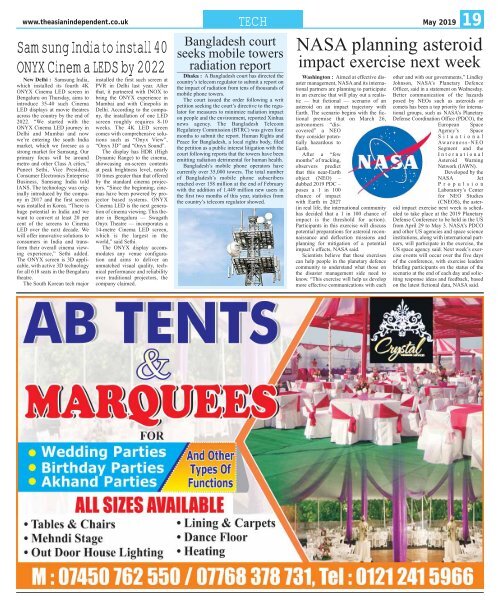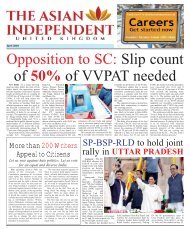You also want an ePaper? Increase the reach of your titles
YUMPU automatically turns print PDFs into web optimized ePapers that Google loves.
www.theasianindependent.co.uk<br />
Samsung India to install 40<br />
ONYX Cinema LEDS by 2022<br />
New Delhi : Samsung India,<br />
which installed its fourth 4K<br />
ONYX Cinema LED screen in<br />
Bengaluru on Thursday, aims to<br />
introduce 35-40 such Cinema<br />
LED displays at movie theatres<br />
across the country by the end of<br />
2022. “We started with the<br />
ONYX Cinema LED journey in<br />
Delhi and Mumbai and now<br />
we’re entering the south India<br />
market, which we foresee as a<br />
strong market for Samsung. Our<br />
primary focus will be around<br />
metro and other Class A cities,”<br />
Puneet Sethi, Vice President,<br />
Consumer Electronics Enterprise<br />
Business, Samsung India told<br />
IANS. The technology was originally<br />
introduced by the company<br />
in 2017 and the first screen<br />
was installed in Korea. “There is<br />
huge potential in India and we<br />
want to convert at least 20 per<br />
cent of the screens to Cinema<br />
LED over the next decade. We<br />
will offer innovative solutions to<br />
consumers in India and transform<br />
their overall cinema viewing<br />
experience,” Sethi added.<br />
The ONYX screen is 3D applicable,<br />
with active 3D technology<br />
for all 618 seats in the Bengaluru<br />
theatre.<br />
The South Korean tech major<br />
installed the first such screen at<br />
PVR in Delhi last year. After<br />
that, it partnered with INOX to<br />
bring the ONYX experience in<br />
Mumbai and with Cinepolis in<br />
Delhi. According to the company,<br />
the installation of one LED<br />
screen roughly requires 8-10<br />
weeks. The 4K LED screen<br />
comes with comprehensive solutions<br />
such as “Onyx View”,<br />
“Onyx 3D” and “Onyx Sound”.<br />
The display has HDR (High<br />
Dynamic Range) to the cinema,<br />
showcasing on-screen contents<br />
at peak brightness level, nearly<br />
10 times greater than that offered<br />
by the standard cinema projectors.<br />
“Since the beginning, cinemas<br />
have been powered by projector<br />
based systems. ONYX<br />
Cinema LED is the next generation<br />
of cinema viewing. This theatre<br />
in Bengaluru — Swagath<br />
Onyx Theatre — incorporates a<br />
14-metre Cinema LED screen,<br />
which is the largest in the<br />
world,” said Sethi.<br />
The ONYX display accommodates<br />
any venue configuration<br />
and aims to deliver an<br />
unmatched visual quality, technical<br />
performance and reliability<br />
over traditional projectors, the<br />
company claimed.<br />
TECH<br />
Bangladesh court<br />
seeks mobile towers<br />
radiation report<br />
Dhaka : A Bangladesh court has directed the<br />
country’s telecom regulator to submit a report on<br />
the impact of radiation from tens of thousands of<br />
mobile phone towers.<br />
The court issued the order following a writ<br />
petition seeking the court’s directive to the regulator<br />
for measures to minimize radiation impact<br />
on people and the environment, reported Xinhua<br />
news agency. The Bangladesh Telecom<br />
Regulatory Commission (BTRC) was given four<br />
months to submit the report. Human Rights and<br />
Peace for Bangladesh, a local rights body, filed<br />
the petition as a public interest litigation with the<br />
court following reports that the towers have been<br />
emitting radiation detrimental for human health.<br />
Bangladesh’s mobile phone operators have<br />
currently over 35,000 towers. The total number<br />
of Bangladesh’s mobile phone subscribers<br />
reached over 158 million at the end of February<br />
with the addition of 1.449 million new users in<br />
the first two months of this year, statistics from<br />
the country’s telecom regulator showed.<br />
Washington : Aimed at effective disaster<br />
management, NASA and its international<br />
partners are planning to participate<br />
in an exercise that will play out a realistic<br />
— but fictional — scenario of an<br />
asteroid on an impact trajectory with<br />
Earth. The scenario begins with the fictional<br />
premise that on March 26,<br />
astronomers “discovered”<br />
a NEO<br />
they consider potentially<br />
hazardous to<br />
Earth.<br />
After a “few<br />
months” of tracking,<br />
observers predict<br />
that this near-Earth<br />
object (NEO) –<br />
dubbed <strong>2019</strong> PDC –<br />
poses a 1 in 100<br />
chance of impact<br />
with Earth in 2027<br />
(in real life, the international community<br />
has decided that a 1 in 100 chance of<br />
impact is the threshold for action).<br />
Participants in this exercise will discuss<br />
potential preparations for asteroid reconnaissance<br />
and deflection missions and<br />
planning for mitigation of a potential<br />
impact’s effects, NASA said.<br />
Scientists believe that these exercises<br />
can help people in the planetary defence<br />
community to understand what those on<br />
the disaster management side need to<br />
know. “This exercise will help us develop<br />
more effective communications with each<br />
<strong>May</strong> <strong>2019</strong><br />
19<br />
NASA planning asteroid<br />
impact exercise next week<br />
other and with our governments,” Lindley<br />
Johnson, NASA’s Planetary Defence<br />
Officer, said in a statement on Wednesday.<br />
Better communication of the hazards<br />
posed by NEOs such as asteroids or<br />
comets has been a top priority for international<br />
groups, such as NASA’s Planetary<br />
Defense Coordination Office (PDCO), the<br />
European Space<br />
Agency’s Space<br />
Situational<br />
Awareness-NEO<br />
Segment and the<br />
International<br />
Asteroid Warning<br />
Network (IAWN).<br />
Developed by the<br />
NASA Jet<br />
Propulsion<br />
Laboratory’s Center<br />
for NEO Studies<br />
(CNEOS), the asteroid<br />
impact exercise next week is scheduled<br />
to take place at the <strong>2019</strong> Planetary<br />
Defense Conference to be held in the US<br />
from April 29 to <strong>May</strong> 3. NASA’s PDCO<br />
and other US agencies and space science<br />
institutions, along with international partners,<br />
will participate in the exercise, the<br />
US space agency said. Next week’s exercise<br />
events will occur over the five days<br />
of the conference, with exercise leaders<br />
briefing participants on the status of the<br />
scenario at the end of each day and soliciting<br />
response ideas and feedback, based<br />
on the latest fictional data, NASA said.
















